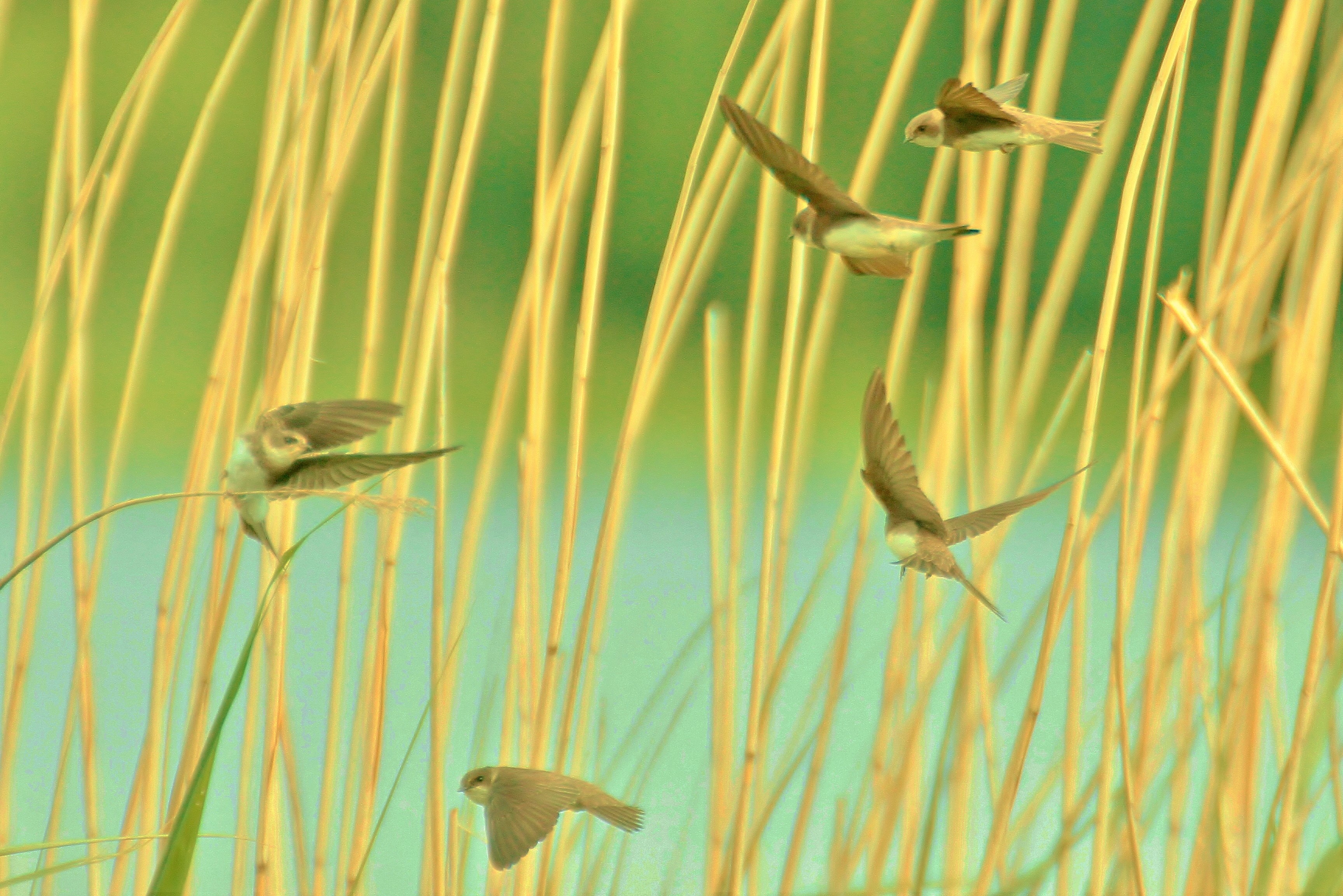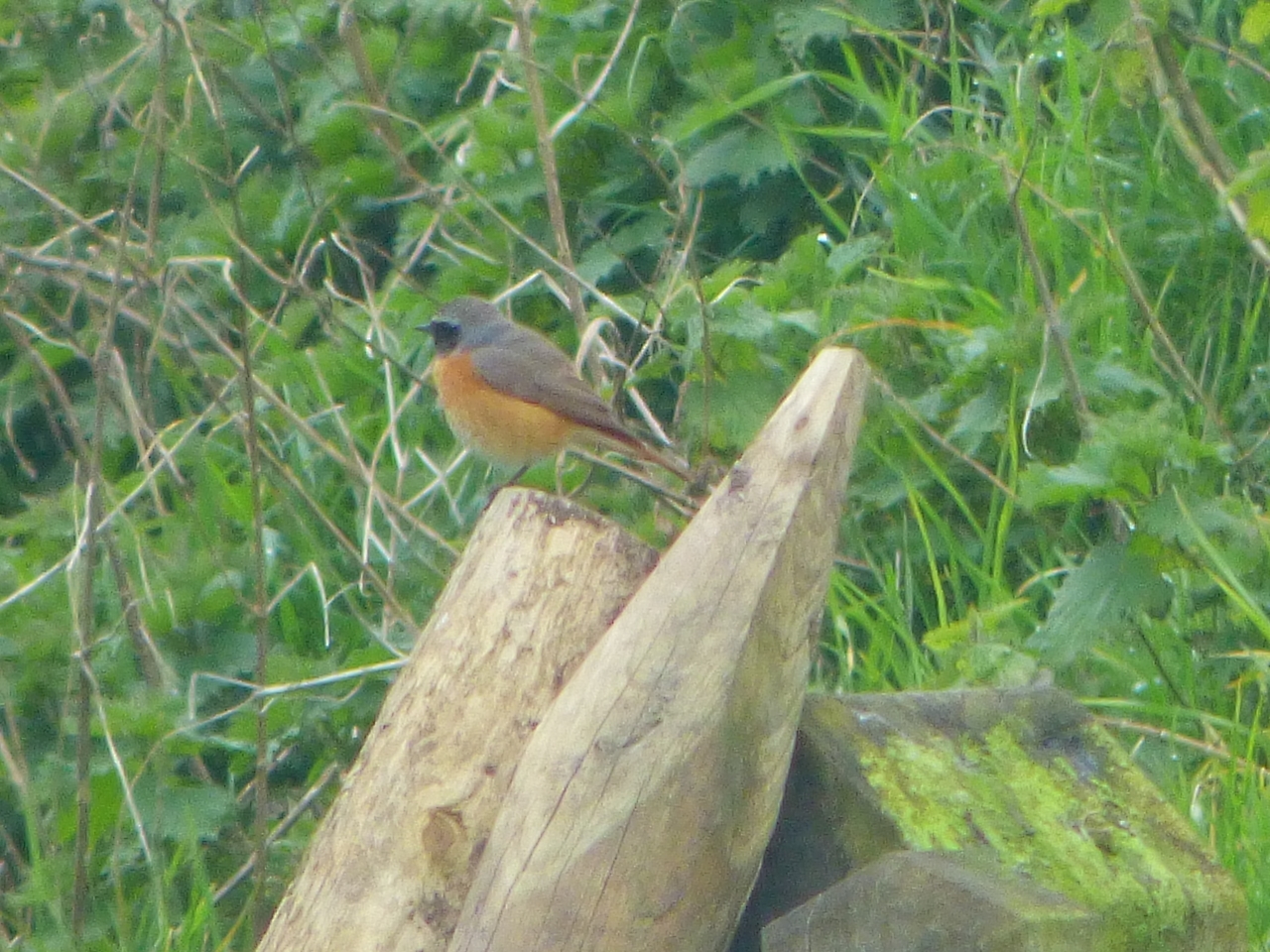 Abraham Lincoln
If given the truth, the people can be depended upon to meet any national crisis...
Abraham Lincoln
If given the truth, the people can be depended upon to meet any national crisis...
 Guildford news...
for Guildford people, brought to you by Guildford reporters - Guildford's own news service
Guildford news...
for Guildford people, brought to you by Guildford reporters - Guildford's own news service
Birdwatcher’s Diary No.106
Published on: 18 Apr, 2016
Updated on: 17 Apr, 2016
By Malcolm Fincham
Cancelling our usual trip to the coast during the Easter weekend due to weather conditions, we decided on a visit to Pulborough Brooks instead. It was as the tail end of Storm Katie passed through.
Using the hides there to shelter from the heavy showers, we often had to keep the viewing windows closed to stay protected from the prevailing wind, carrying with it rain horizontal in nature.

Closer encounters of sand martins last summer at Frensham pond. Click on all pictures to enlarge in a new window.
Although unproductive in the way of seeing any early arrivals of summer migrant species, apart from distant views of a few sand martins, for me it did turn out to be a worthwhile visit.
Among the waders and wildfowl still wintering there was unusual looking wigeon. On close inspection and having taken a few record shots, I realised what it was. It took a while to digest that it was in fact an American wigeon. Perhaps brought in across the Atlantic on the tail end of the prevailing winds?
Also present was the resident peregrine, perched in its favourite tree, overlooking the scrape.
From this vantage point it was able to get a panoramic view of the entire brooks. And when the mood suited, it would take flight, scaring up the waders and waterfowl as it looked out for an unsuspecting critter to take for prey.
A trip to Pagham RSPB reserve in West Sussex the following weekend was much more productive. A pair of avocets could be seen feeding in Sidlesham Ferry pool.
Having heard a willow wabler singing there, I was able to get my first record shot this year of a summer migrant. A redstart, having flown all the way from Africa to spend the summer here.
While visiting Church Norton near Pagham there were a “doading” or “dopping” of shelducks (according to collective nouns). These seemed to be in some dispute with each other, possibly a good sign of the approaching breeding season?
Adding to our sightings there were a group of turnstones, conducting their usual ritual of turning over stones on the shoreline, looking for a snack.
Several little egret were also present.
In a field nearby, a pair of red-legged partridges could be seen as they grazed, sheltered from sight at the edge of some farmland.
As we moved into April, I began to get sightings of some of our UK summer arrivals on my local patch at the Riverside Nature Reserve.
My first new sighting of the year there was a common whitethroat on April 12. Looking a little shy on its arrival, with a little patience, it finally allowed me a photo-shot.
The following evening six or more swallows had arrived, hawking for insects over the water at Stoke Lake.
By accident I even managed to pick out a kingfisher perched in the sallows on the far side of the lake.
A blackcap also made an appearance, singing its charming song as I snapped a few shots.
Now starting to pair up were treecreepers seen together in a wooded area.
While nuthatches could be heard making their wolf-whistle-like calls.
And the pair of mute swans looking relaxed as they formed heart shapes with their necks.
More advanced were a pair of coots now with a clutch of chicks.
A dabchick took me by surprise as it popped up from the reeds at the waters edge by Stoke Lake.
While out on the flooded field a pair of wintering shovelers could still be seen.
On a sunny sunny evening, in a quiet location on our Surrey borders, I found myself in ”Nivirna” as I watched a sight that I could only have dreamt of just a few years ago – that of red kites. Allowing myself to ”fill me boots” with a montage of photos while I watched in awe.

With an impressive wingspan and bright yellow eyes, the red kite also has a distinctive forked tail which it uses like a rudder when in flight.
Many species of birds have been in decline throughout many parts of the UK due to various reasons, such as loss of habitat, due to urbanisation as well as changes of farming methods during the last few decades, especially in the Surrey area. But we have to be thankful for conservation work that is being carried out by http://www.

Road-casualty pheasants, rabbits and squirrels form an important part of the diet of the reintroduced kites in England.
So it’s good to be enlightened by a few success stories in recent years that some birds and mammals are actually starting to increase in number. And seen in increasing numbers in the Surrey area in recent years are sightings of red kites.

The reintroduction of the red kite to England and Scotland has been one of the major conservation success stories of the last 20 years.
Once a common sight around towns and cities prior to the Victorian era and even mentioned by Shakespeare in A winter’s Tale. He was clearly aware of the kite’s habitat of adorning its nest with frilly material, including underwear.

Historically, the kite was associated with towns and cities where it was valued as a scavenger, helping keep streets clean.
Another name for the kite often used by Shakespeare was the ‘paddock’ or ‘puttock’. And perhaps the greatest nature poet John Clare wrote these words in about 1820 to create some beautiful imagery of the kite in flight.
“Ah, I could see a spinner nigh / A paddock riding in the sky / Above the oaks in easy sail / On stilly wings and forked tail.”

Kites are surprisingly lightweight. In the spring adults weigh around 900gm, which is considerably less than a mallard duck.
At one time in the UK, red kites were ubiquitous scavengers that lived on carrion and rubbish. In a quite location on the Surrey borders I was able to locate one in action.
Although this particular one didn’t appear to be looking for underwear. It was certainly hunting around a field looking for prey. Taken in by the spender of its flight, I couldn’t resist the chance of taking a few photos while I watched its magnificent display.

Kites hunt on the wing, soaring and circling over open ground. They are mainly carrion eaters, but are quite capable of killing small mammals.
Although large in size they are, in fact, quite light in weight for a bird of prey, and not so well adapted to catching live food as most raptors.
With the weather starting to warm as we approached mid-April a few bats could be seen, out of hibernation along the River Wey as dusk approached.
With some days of warm sunshine, wood ants have started to become active.
And an increase of brimstone and peacock sightings was a reminder to me butterfly season was starting too.
Responses to Birdwatcher’s Diary No.106
Leave a Comment Cancel replyPlease see our comments policy. All comments are moderated and may take time to appear.
Recent Articles
- Guildford Institute’s Crowdfunding Project for Accessible Toilet in its New Community and Wellbeing Centre
- Letter: Guildford – Another Opportunity Missed?
- Letter: GBC’s Corporate Strategy – Where Is the Ambition?
- My Memories of John Mayall at a Ground-breaking Gig in Guildford Nearly Six Decades Ago
- Westborough HMO Plans ‘Losing the Heart of the Street’ Says Resident
- College Invests to Boost Surrey’s Economy and Close Digital Skills Gap
- Community Lottery Brings Big Wins for Local Charities
- GBC Housing Plan Promises ‘A Vibrant Urban Neighbourhood’ Near Town Centre
- Hospital Pillows ‘Shortage’ at the Royal Surrey
- Updated: Caravans Set Up Camp at Ash Manor School


Recent Comments
- Ian Macpherson on Updated: Main Guildford to Godalming Road Closed Until August 1
- Sara Tokunaga on GBC Housing Plan Promises ‘A Vibrant Urban Neighbourhood’ Near Town Centre
- Michael Courtnage on Daily Mail Online Reports Guildford Has Highest-paid Council Officer
- Alan Judge on GBC Housing Plan Promises ‘A Vibrant Urban Neighbourhood’ Near Town Centre
- John Perkins on GBC Housing Plan Promises ‘A Vibrant Urban Neighbourhood’ Near Town Centre
- S Collins on GBC Housing Plan Promises ‘A Vibrant Urban Neighbourhood’ Near Town Centre
Search in Site
Media Gallery
Dragon Interview: Local Artist Leaves Her Mark At One of England’s Most Historic Buildings
January 21, 2023 / No Comment / Read MoreDragon Interview: Lib Dem Planning Chair: ‘Current Policy Doesn’t Work for Local People’
January 19, 2023 / No Comment / Read MoreA3 Tunnel in Guildford ‘Necessary’ for New Homes, Says Guildford’s MP
January 10, 2023 / No Comment / Read More‘Madness’ for London Road Scheme to Go Ahead Against ‘Huge Opposition’, Says SCC Leader
January 6, 2023 / No Comment / Read MoreCouncillor’s Son Starts Campaign for More Consultation on North Street Plan
December 30, 2022 / No Comment / Read MoreCounty Council Climbs Down Over London Road Works – Further ‘Engagement’ Period Announced
December 14, 2022 / No Comment / Read MoreDragon Interview: GBC Reaction to the Government’s Expected Decision to Relax Housing Targets
December 7, 2022 / No Comment / Read MoreHow Can Our Town Centre Businesses Recover? Watch the Shop Front Debate
May 18, 2020 / No Comment / Read More































James Sellen
April 18, 2016 at 10:55 pm
Excellent set of Red Kite photos – an awesome bird we’re now lucky to see in Surrey.